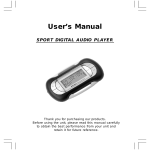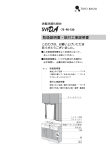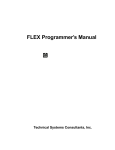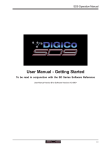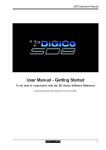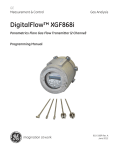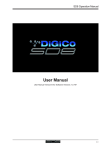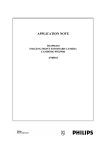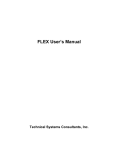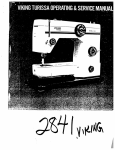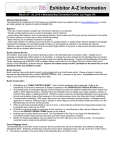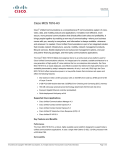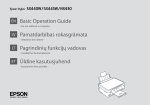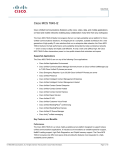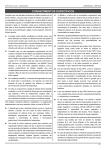Download Assembler Manual THE COMMODORE PET ASSEMBLER
Transcript
Assembler Manual THE COMMODORE PET ASSEMBLER DEVELOPMENT SYSTEM Copyright 1979, Commodore Business Machines Professional Computer Division 1200 Wilson Drive West Chester, PA 19380 COPYRIGHT This software product is copyrighted and all rights reserved. The distribution and sale of this product are intended for the use of the original purchaser only. Lawful users of this program are hereby licensed only to read the program, from its medium into memory of a computer, solely for the purpose of executing the program. Duplicating, copying, selling or otherwise distributing this product is a violation of the law. This manual is copyright and all rights are reserved. This document may not, in whole or part, be copied, photocopied, reproduced, translated or reduced to any electronic medium or machine readable form without prior consent, in writing, from Commodore Business Machines (CBM). PREFACE The Commodore PET ASSEMBLER DEVELOPMENT SYSTEM software package allows you to program in the native 6500 series Assembly language code, directly on the Commodore PET computer. It provides you with a very powerful assembler, editor and loader. These development tools operate like and provide the same level of direct machine interface as the assemblers on much larger computers. This package contains everything that you will need to create, assemble, load and execute 6500 series Assembly language code. You will notice that like the software, this user's manual is directed towards the experienced computer user that already has some familiarity with the 6500 series Assembly language and the operations of the Commodore PET computer. This product is not intended to provide the knowledge of 'how to' in assembly language, but provides the software tools for the experienced assembly language programmer. It is recommended that the user obtain one or more of the reference manuals listed below for a more detailed description of 6502 assembly language and the Commodore PET. (The publisher is listed in parenthesis.) o 6502 Assembly Language Subroutines, Leventhal and Saville (Osborne/McGraw-Hill) o 6502 Software Design, Scanlon (Howard W. Sams & Co.) o 6502 Assembly Language Programming, Leventhal (Osborne/McGraw-Hill) o Commodore Programmer's Reference Guide (Commodore/Howard W. Sams & Co.) o Programming in 6502, Rodnay Zaks (Sybex) This manual has been divided into five parts for easier reference. Part One, "Introduction" provides a brief description of how an assembler works along with some basic terminology used throughout this manual. It is recommended that the novice user read this section first to obtain a feel for the level of knowledge needed to program in assembly language and use this manual. Part Two, "PET Assembler Capabilities and Conventions", is composed of Sections 1-3 and describes those capabilities and conventions used by Seite 1 Assembler Manual this assembler. Part Three, "Creating and Editing Assembly Source Files", is composed of Section 4 and describes how to create and edit an assembly language source file. Section 4 contains the operating instructions for loading and running the Editor program. This program allows the user to create and edit assembly source files. Part Four of the manual, "Assembling and Testing a Program", is composed of Sections 5-6 and contains information on the programs that allow the user to assemble and test object programs. Section 5 describes the operation of the assembler program; Section 6 describes the program that must be used to load an object program into memory. Finally, Part Five, "Appendices", includes those charts and tables that can be used as a reference to other sections. It also provides a quick reference to the commands available when running certain programs. USER CONVENTIONS Throughout this manual there are certain conventions used to help make explanations less ambiguous. A list of these conventions is given below. We recommend that the user become familiar with these. ( ) Parentheses are used to denote an option. The only exceptions to this rule are in those sections where indirect indexed and indexed indirect addressing are explained. In these cases the parentheses are required. label This is used to denote a label reference in an assembler source program. The actual label used is determined by the programmer. opcode This is used to denote one of the 6502 instructions as specified in Appendix II. operand This is used to denote the operand, or argument portion of an instruction. comments This is used to specify user comments. filename This is used to specify a filename on disk. The actual name is determined by the user. filename* This is used to denote a wild card filename (i.e., a filename that begins with the characters preceding the "*"). lower case variable Generally, lower case variables specify that it is up to you to supply the actual data. UPPER CASE NAMES Generally, UPPER CASE NAMES are the actual input to be typed. TABLE OF CONTENTS PET ASSEMBLER CAPABILITIES AND CONVENTIONS 1.0 INSTRUCTION FORMAT CONVENTIONS 1.1 Symbolic 1.2 Constants 1.3 Relative 1.4 Implied 1.5 Indexed Indirect 1.6 Indirect Indexed 2.0 ASSEMBLER DIRECTIVES 3.0 OUTPUT FILES GENERATED BY THE ASSEMBLER Seite 2 Assembler Manual CREATING AND EDITING ASSEMBLY SOURCE FILES 4.0 CREATING AND EDITING A SOURCE FILE 4.1 Loading the Editor Program 4.2 Using the Editor Program 4.3 Editor Program Commands ASSEMBLY AND TESTING A PROGRAM 5.0 ASSEMBLING A SOURCE FILE 5.1 Loading the Assembler Program 5.2 Using the Assembler Program 6.0 LOADING AN OBJECT FILE 6.1 Loading the Loader Program 6.2 Using the Loader Program APPENDICES Appendix I Appendix II Appendix III Appendix IV Appendix V DESCRIPTION OF FILES 6500 SERIES MICROPROCESSOR INSTRUCTION SET OPCODES A SAMPLE OUTPUT LISTING OF THE COMMODORE PET ASSEMBLER EXPLANATION OF ERROR MESSAGES EDITOR COMMAND SUMMARY INTRODUCTION This manual describes the Assembly Language and assembly process for Commodore PET programs which use one of the 6500 series microprocessors. Several assemblers are available for 6500 series program development, each is slightly different in detail of use, yet all are the same in principle. The 6500 series processors include the 6502 through the 6515 (the instruction sets are identical). The process of translating a mnemonic or symbolic form of a computer program to actual machine code is called assembly, and a program which performs the translation is an assembler. We refer to the symbolic form of the program as source code and the actual association for those symbols are the Assembly Language. In general, one Assembly Language statement will translate into one machine instruction. This distinguishes an assembler from a compiler which may produce many machine instructions from a single statement. An assembler which executes on a computer other than the one for which code is generated, is called a cross-assembler. Use of cross-assemblers for program development for microprocessors is common because often a microcomputer system has fewer resources than are needed for an assembler. However, in the case of the Commodore PET, this is not true. With a floppy disk and printer, the system is well suited for software development. Normally, digital computers use the binary number system for representation of data and instructions. Computers understand only ones and zeros corresponding to an 'ON' or 'OFF' state. Users, on the other hand, find it difficult to work with the binary number system and hence, use a more convenient representation such as octal (base 8), decimal (base 10), or hexadecimal (base 16). Two representations of the 6500 series operation to 'load' information into an 'accumulator' are: 10101001 A9 (binary) (hexadecimal) An instruction to move the value of 21 (decimal) to the accumulator is: A9 15 (hexadecimal) Users still find numeric representations of instructions tedious to work with, and hence, have developed symbolic representations. For example, the preceding instruction might be written as: LDA #21 Seite 3 Assembler Manual In this example, LDA is the symbol for A9, Load the Accumulator. An assembler can translate the symbolic form LDA to the numeric form A9. Each machine instruction to be executed has a symbolic name referred to as an operation code (opcode). The opcode for "store accumulator" is STA. The opcode for "transfer accumulator to index x" is TAX. The 56 opcodes for the 6500 series processors are detailed in Appendix II. A machine instruction in Assembly Language consists of an opcode and perhaps operands, which specify the data on which the operation is to be performed. A label is a 'name' for a line of code. Instructions may be labelled for reference by other instructions, as shown in: L2 LDA #12 The label is L2, the opcode is LDA, and the operand is #12. At least one blank must separate the three parts (fields) of the instruction. Additional blanks may be inserted by the programmer for ease of reading. Instructions for the 6500 series processors have at most one operand and may have none. In these cases, the operation to be performed is totally specified by the opcode as in CLC (Clear the Carry Bit). Programming in Assembly Language requires learning the instruction set (opcodes), addressing conventions for referencing data, the data structures within the processor, as well as the structure of Assembly Language programs. The user will be aided in this by reading and studying the 6500 series hardware and programming manuals supplied with this development package. 1.0 INSTRUCTION FORMAT CONVENTIONS Assembler instructions for the Commodore PET Assembler are of two basic types according to function: o Machine instructions, and o Assembler directives Machine instructions correspond to the 56 operations implemented on the 6500 series processors. The instruction format is: (label) opcode (operand) (comments) Fields are bracketed to indicate that they are optional. Labels and comments are always optional and many opcodes such as RTS (Return from Subroutine) do not require operands. A line may also contain only a label or only a comment. A typical instruction showing all four fields is: LOOP LDA BETA,X ;FETCH BETA INDEXED BY X A field is defined as a string of characters separated by a space. A label is an alphanumeric string of from one to six characters, the first of which must be alpha. A label may not be any of the 56 opcodes, nor any of the special single characters, i.e. A, S, P, X or Y. These special characters are used by the assembler to reference the: o o o o Accumulator (A) Stack pointer (S) Processor status (P) Index registers (X and Y) A label may begin in any column provided, it is the first field of an instruction. Labels are used on instructions as branch targets and on data elements for reference in operands. Seite 4 Assembler Manual The operand portion of an instruction specifies either an address or a value. An address may be computed by expression evaluation and the assembler allows considerable flexibility in expression formation. An Assembly Language expression consists of a string of names and constants separated by operators, +, -, *, and / (add, subtract, multiply, and divide). Expressions are evalued by the assembler to computer operand addresses. Expressions are evaluated left to right with no operator precedence and no parenthetical grouping. Note that expressions are evaluated at assembly time and not execution time. Any string of characters following the operand field is considered a comment and is listed, but not further processed. If the first nonblank character of any record is a semi-colon (;), the record is processed as a comment. On instructions which require no operand, comments may follow the opcode. At least one space must separate the fields of an instruction. Appendix III presents a sample output listing from the assembler. Various examples of instruction format are included. 1.1 Symbolic Perhaps the most common operand addressing mode is the symbolic form as in: LDA BETA ;PUT BETA VALUE IN ACCUMULATOR In this example, BETA is a label referencing a byte in memory that contains the value to be loaded into the accumulator. BETA is a label for an address at which the value is located. Similarly, in the instruction: LDA ALPHA + BETA the address ALPHA + BETA is computed by the assembler, and the value at the computer address is loaded into the accumulator. Memory associated with the 6500 series processors is segmented into pages of 256 bytes each. The first page, page zero, is treated differently by the assembler and processor for optimization of memory storage space. Many of the instructions have alternate operation codes if the operand address is in page zero memory. In those cases, the address is only one byte rather than the normal two. For example: LDA BETA If BETA is located at byte 4B in page zero memory, then the code generated is A5 B4. This is called page zero addressing. If BETA is at 013C, which is located in memory page one, the code generated is AD 3C 01. This is an example of 'absolute' addressing. Thus, to optimize storage and execution time, a programmer should design with data areas in page zero memory whenever possible. (Please avoid assembling code in page zero, as problems may be encountered.) Remember, the assembler makes decisions on which form to use, based on operand address computation. 1.2 Constants Constant values in Assembly Language can take several forms. If a constant is other than decimal, a prefix character is used to specify type: $ @ % (Dollar sign) specifies hexadecimal (Commercial at) specifies octal (Percent) specifies binary Seite 5 Assembler Manual (Apostrophe) specifies an ASCII literal character in immediate instructions. ' The absence of a prefix symbol indicates decimal a value. In the statement: LDA BETA + 5 the decimal number 5 is added to BETA to compute the address. Similarly, LDA BETA + $5F denotes that the hexadecimal value of 5F is to be added to BETA for the address computation. The immediate mode of addressing is signified by a # (pound sign) followed by a constant. For example: LDA #2 specifies that the decimal value 2 is to be put into the accumulator. Similarly, LDA #'G will load the ASCII value of character G into the accumulator. Since the accumulator is one byte, the value loaded must be in the range of 0 to 255 (decimal). Note that constant values can be used in address expressions and as values in immediate mode addressing. They can also be used to initialize locations as explained in a later section as assembler directives. 1.3 Relative There are eight conditional branch instructions available to the user. In this example: BEQ START ;IF EQUAL BRANCH TO START If the values compared are equal, a transfer to the instruction labelled START is made. The branch address is a one byte positive or negative offset which is added to the program counter during execution. At the time the addition is made, the program counter is pointing to the next instruction beyond the branch instruction. The offset is based on the location of the next instruction. A branch address must be within 127 bytes forward or 128 bytes backward from the conditional branch instruction. An error will be flagged at assembly time if a branch target falls outside the bounds for relative addressing. Relative addressing is not used for any instructions other than branch. 1.4 Implied Twenty-five instructions such as TAX (Transfer Accumulator to Index X) require no operand, and hence, are single byte instructions. Thus, the operand addresses are implied by the operation code. Four instructions, ASL, LSR, ROL, and ROR, are special in that the accumulator, A, can be used as an operand. In this special case, these four instructions are treated as implied mode addressing and only an operation code is generated. 1.5 Indexed Indirect Seite 6 Assembler Manual In this mode, the operand address is computed by first adding the X register (the index) to the argument in the operand (in the example below, BETA). The resulting value is the indirect page zero address which contains the actual operand address. In this example: LDA (BETA,X) the parentheses around the operand indicates indirect mode. In the above example, the value in index register X is added to BETA. That sum must reference a location in page zero memory. During execution, the high order byte of the address is ignored; thus, forcing a page zero address. The two bytes starting at that location in page zero memory are taken as the address of the operand in low byte, high byte format. For purposes of illustration, assume the following: BETA contains $12 X contains $04 Locations $0017 and $0016 contain $01 and $25 Location $0125 contains $37 Then BETA + X is $16, the address at location $16 is $0125, the value at $0125 is $37, and hence the instruction LDA (BETA,X) loads the value $37 into the accumulator. (This addressing mode is often used for accessing a table of address vectors in page zero.) This form of addressing is shown in the following illustration. LDA (BETA,X) Address +---------+ | $12 | + $04 = $0016 +---------+ BETA +---------+ | $25 | Treated as Low Byte +---------+ | $01 | Treated as High Byte, result is $0125 +---------+ $0016 $0017 +---------+ | $37 | This value is loaded into the Accumulator +---------+ $0125 1.6 Value Indirect Indexed Another mode of indirect addressing uses index register Y and is illustrated by: LDA (GAMMA),Y In this case, GAMMA references a page zero location at which an address is to be found. The value in index Y is added to that address to compute the actual address of the operand. Suppose for example that: GAMMA contains $38 Y contains $07 Locations $0039 and $0038 contain $00 and $54 Location $005B contains $26 The address at $38 is $0054; seven is then added to this, giving an effective address $005B. The value at $005B is $26 which is loaded into the accumulator. In indexed indirect, the index X is added to the operand prior to the indirection. In indirect indexed, the indirection is done and then the Seite 7 Assembler Manual index Y is added to compute the effective address. Indirect mode is always indexed except for a JMP instruction which allows an absolute indirect address, as exemplified by JMP (DELTA) which causes a branch to the address contained in locations DELTA and DELTA + 1. The indirect indexed mode of addressing is shown in the following illustration. LDA (GAMMA),Y Address GAMMA $0038 $0039 $005B 2.0 Value +---------+ | $38 | +---------+ +---------+ | $54 | Treated as low byte +---------+ | $00 | Treated as high byte, result is $0054 +---------+ Add $07 from Y, result is $005B +---------+ | $26 | This value is loaded into the Accumulator +---------+ ASSEMBLER DIRECTIVES There are eleven assembler directives used to reserve storage and direct information to the assembler. Nine have symbolic names with a period as the first character. The tenth, a symbolic equate, uses an equals sign (=) to establish a value for a symbol. The eleventh, asterisk (*), means the value of the current location counter. This corresponds to the ORG directive in some assemblers. It is sometimes read as "here" or "this location". Some equate examples are "RED = 5", "BLUE = $FF", and "* = $0200". A list of the directives is given below (their use is explained in this section): .BYTE .OPT = * .WORD .END .DBYTE .PAGE .FILE .LIB .SKIP Labels and symbols other than directives may not begin with a period. Examples of assembler directives can be seen in the sample Assembler program in Appendix III. If desired, all directives which are preceded by the period may be abbreviated to the period and three characters, e.g., '.BYT'. .BYTE is used to reserve one byte of memory and load it with a value. The directive may contain multiple operands which will store values in consecutive bytes. ASCII strings may be generated by enclosing the string with quotes. (All quotes are "single" quotes, i.e., SHIFT 7.) It should be noted, however, that there is a limitation of 40 ASCII characters that can be stored in each .BYTE directive. HERE THERE ASCII .BYTE 2 .BYTE 1, $F, @3, %101, 7 .BYTE 'ABCDEFH' Note that numbers may be represented in the most convenient form. In general, any valid 6500 series expression which can be resolved to eight bits, may be used in this directive. If it is desired to include a quote in an ASCII string, insert two quotes in the string. For example: .BYTE 'JIM''S CYCLE' Seite 8 Assembler Manual could be used to store: JIM'S CYCLE It should be noted that the use of arithmetic operations in the .BYTE directive is not supported in this version of the package. .WORD is used to reserve and load two bytes of data at a time. Any valid expression, except for ASCII strings, may be used in the operand field. For example: HERE THERE WHERE .WORD 2 .WORD 1, $FF03, @3 .WORD HERE, THERE The most common use for .WORD is to generate addresses as shown in the previous example labelled "WHERE", which stores the 16 bit address of "HERE" and "THERE". Addresses in the 6500 series are fetched from memory in the order low-byte, then high-byte. Therefore, .WORD generates the value in this order. The hexadecimal portion of the example ($FF03) would be stored $03, $FF. If this order is not desired, use .DBYTE rather than .WORD. .DBYTE is exactly like .WORD, except the bytes are stored in high-byte, low-byte order. For example: .DBYTE $FF03 will generate $FF, $03. Thus, fields generated by .DBYTE may not be used as indirect addresses. An advanced technique is to set up vector tables under the assembler directive .DBYTE and to push the starting vector address onto the stack, then execute an RTS instruction to access your routine. Remember that the addresses for the operands should be the actual address location minus one. When constructing a JUMP table in the usual way using an indirect jump instruction (opcode JMP ($6C)), do not subtract one from the address of the operand. Equal (=) is the EQUATE directive and is used to reserve memory locations, reset the program counter (*), or assign a value to a symbol. HERE * = * + 1 WHERE * = * + 2 * = $200 NB = 8 MB = NB + %101 ;RESERVE ONE BYTE ;RESERVE TWO BYTES ;SET PROGRAM COUNTER ;ASSIGN VALUE ;ASSIGN VALUE The '=' directive is very powerful and can be used for a wide variety of purposes. Asterisk (*) directive is used to change the program counter. To create an object code program that starts assembly at any address greater than zero, the '*' directive must be used. For example, '* = $200' starts assembling at address $200. Expressions must not contain forward references or they will be flagged as an error. For example: * = C + D - E + F would be legal if C, D, E and F are all defined, but would be illegal if any of the variables were defined later on in the program. Note also that expressions are evaluated in strict left to right order. .PAGE is used to cause an immediate jump to the top of page on the output listing and may also be used to generate or reset the title Seite 9 Assembler Manual printed at the top of the output listing. .PAGE .PAGE .PAGE 'THIS IS A TITLE' 'NEW TITLE' If a title is defined, it will be printed at the top of each page until it is redefined or cleared. A title may be cleared with: .PAGE ' ' .SKIP is used to generate blank lines in a listing. The directive will not appear, but its position may be found in a listing. The directive is treated as a valid input "list" and the list number printed on the left side of the listing will jump by two when the next line is printed. .SKIP .SKIP .SKIP 2 3 * 2 - 1 ;SKIP TWO BLANK LINES ;SKIP FIVE LINES ;SKIP ONE LINE .OPT is the most powerful directive and is used to control the generation of output fields, listings and expansion of ASCII strings in .BYTE directives. The options available are: ERRORS, NOERRORS, LIST, NOLIST, GENERATE, NOGENERATE, SYM, and NOSYM. .OPT .OPT ERRORS, LIST, GENERATE NOE, NOL, NOG Also valid is: .OPT LIST, ERR Default Settings are: .OPT LIST, ERR, NOGEN Here are descriptions for each of the options: ERRORS, NOERRORS: Used to control creation of a separate error file. The error file contains the source line in error and the error message. This facility is normally of greatest use to time-sharing users who have limited print capacity. The error file may be turned on and examined until all errors have been corrected. This listing file may then be examined. Another possibility is to run with: .OPT ERROR, NOLIST until all errors have been corrected, and then make one more run with: .OPT NOERRORS, LIST LIST, NOLIST: Used to control the generation of the listing file which contains source input, errors/warnings, code generation, symbol table and instruction count if enabled. GENERATE, NOGENERATE: Used to control printing of ASCII strings in the .BYTE directive. The first two characters will always be printed, and subsequent characters will be printed (normally two bytes per line), if GENERATE is used. .END should be the last directive in a file and is used to signal the physical end of the file. Its use is optional, but highly recommended for program documentation. .LIB allows the user to insert source code from another file into the assembly. When the assembler encounters this directive, it temporarily Seite 10 Assembler Manual ceases reading source code from the current file and starts reading from the file named in the .LIB. Processing of the original source file resumes when end-of-file (EOF) or .END is encountered in the library file. The control file containing the .LIB can contain other assembler directives to turn the listing function on and off, etc. .FIL can be used to link another file to a current one during assembly. A library file called by a .LIB may not contain another .LIB, but it may contain a .FIL. A '.FIL' terminates assembly of the file containing it and transfers source reading to the file named on the OPERAND. There are no restrictions on the number of files which may be linked by .FIL directives. Caution should be exercised when using this directive to ensure that no circular linkages are created. An assembler pass can only be terminated by (EOF) or the .END directive. 3.0 OUTPUT FILES GENERATED BY THE ASSEMBLER There are three output files genereated by the assembler. Each file is optional and can be created through the use of the .OPT assembler directive. The listing file contains the program list with errors and the symbol table. The error file contains all error lines and errors (as included in the listing file). The interface file contains the object code for the loader. Listing File The listing file will be produced unless the NOLIST option is used on the .OPT assembler directive. This file is make up of two sections: Program and Error List, and Symbol Table. o Program and Error List This listings will always be produced unless the NOLIST option is selected. It contains the source statement of the program along with the assembled code. Errors and warnings appear after erroneous statements. (An explanation of error codes is presented in Appendix VI.) A count of the errors and warnings found during the assembly is presented at the end of the program. o Symbol Table The symbol table will always be produced unless the NOSYM option is used. It contains a list of all symbols used in the program, and their addresses. Interface File This file does not contain true object code, but data which can be loaded and converted to machine code by the loader. The format for the first and all succeeding records, except for the last record, is as follows: ; n1n0 a3a2a1a0 (d1d0)1 (d1d0)2 ... (d1d0)23 x3x2x1x0 Where the following statements apply: 1. All characters (n,a,d,x) are the ASCII characters zero through F, each representing a hexadecimal digit. 2. The semicolon is a record mark indicating the start of a record. 3. n1n0 The number of bytes of data in this record (in hexadecimal). Each pair of hexadecimal characters (d1d0) represents a single byte. 4. a3a2a1a0 The hexadecimal starting address for the record. The a3 represents address bits 15 through 12, etc. The 8-bits Seite 11 Assembler Manual represented by (d1d0)1 is stored in address a3a2a1a0; (d1d0)2 is stored in (a3a2a1a0)+1, etc. 5. (d1d0) Two hexadecimal digits representing an 8-bit byte of data. (d1=high-order 4 binary bits and d0=low-order 4 bits). A maximum of 18 (hex) or 24 (decimal) bytes of data per record is permitted. 6. x3x2x1x0 Record check sum. This is the hexadecimal sum of all characters in the record, including the n1n0 and a3a2a1a0, but excluding the record mark and the check sum of characters. To generate the check sum, each byte of data (represented by two ASCII characters) is treated as 8 binary bits. The binary sum of these 8-bit bytes is truncated to 16 binary bits (4 hexadecimal digits) and is then represented in the record as four ASCII characters (x3x2x1x0). The format for the last record in a file is as follows: ; 00 c3c2c1c0 x3x2x1x0 1. ; 00 Zero bytes of data are in this record. The zeros identify this as the final record in a file. 2. c3c2c1c0 This represents the total number of records (in hexadecimal) in this file, NOT including the last record. 3. x3x2x1x0 Check sum for this record. 4.0 CREATING AND EDITING A SOURCE FILE The editor is used to enter and modify source files for the assembler. The editor retains all of the features of the BASIC screen editor and allows AUTOmatic line numbering, FIND, CHANGE, DELETE within a range, and reNUMBER. Other commands include COLD, GET, PUT, BREAK, KILL and FORMAT. All of the commands are detailed in the summary at the end of this section. The editor commands operate in a similar fashion to the commands already existing in the computer's BASIC. For practice, we suggest that you try to create short example files using the editor commands. The data files on which the assembler operates are made up of CBM ASCII characters with each line terminated by a carriage return. The only restriction on data lines is in naming. Due to the method in which the assembler parses, spaces are not allowed in filenames. The files are sequential and must be terminated by a zero byte $00. When listing a directory, these files will show as file type SEQ. Each file's format is sequential, with a terminating zero byte ($00). 4.1 Loading the Editor Program The editor must be loaded with the BASIC SYS command: SYS 59648 After typing the SYS command, the editor has been loaded. At this point, type a NEW command to clear the text pointers. You are now ready to edit or enter assembler source files. 4.2 Using the Editor Program When the Editor Program is in operation, any BASIC statement typed Seite 12 Assembler Manual such as: 10 FOR I = 1 TO 10 will not be tokenized (converted into BASIC keyword tokens). Thus, you cannot type a BASIC line with the editor turned on. To avoid this problem, disable the editor with the 'KILL' command or reset the computer with the 'COLD' command to return to BASIC. Source files are loaded with the 'GET' command. As the file is loaded, the editor generates the line numbers automatically starting at 1000. After editing the file, ensure that the last line in the file is a .FILE or a .END assembler directive. Then, save the file on the disk with the 'PUT' command. Important: Be sure to save your completed file using the PUT command BEFORE loading the assembler or your file will be lost. Refer to Appendix V for an Editor Command Summary. 4.3 Editor Program Commands AUTO Line Numbering The AUTO command generates new line numbers while entering a new source code file. To enable the AUTO command, type the following: AUTO n1 where n1 is the optional increment between line numbers printed. To disable the AUTO function, type the AUTO command without an increment. BREAK Command Calls the built-in TIM-Monitor CHANGE string The CHANGE command automatically locates and replaces one string with another (multiple occurrences). This command is entered in the following format: CHANGE/str1/str2/(,n1-n2) / str1 str2 n1-n2 Delimits the str1 and str2 (use any character not in either string) Search string Replacement string Range parameters. The format is the same as the LIST command in BASIC. If omitted, the whole file is searched. (Optional) COLD Command Performs a cold-start of the PET CPUT Command The CPUT command outputs source files with no unnecessary spaces to the disk for later assembly. The syntax for this command is the same as the PUT command. DELETE The DELETE command allows the user to delete several lines at a time. Simply input the range of lines to be deleted (n1 through n2). (The format is the same as the LIST command in BASIC). Seite 13 Assembler Manual DELETE n1-n2 To delete a single line, enter the line number alone on a blank line and press RETURN. FIND string The FIND command is used to search for and locate specific character strings in text. Each occurrence of the string is printed on the CRT. You can pause the printing with the space bar. Printing can then be continued with the space bar, or terminated with the RUN/STOP key. The format of the FIND command is: FIND/str1/(,n1-n2) / str1 n1-n2 Delimiter (use a character not in the string) Search string Range parameter. Same as the LIST command in BASIC. (Optional) FORMATted Print The FORMAT command is used to print the text file in tabbed format like the assembler. For this function to work correctly, you must type mnemonics in column two, or one space from labels. FORMAT (n1-n2) n1-n2 Range parameters of the same format as LIST. (Optional) Note: This command has the same controls as FIND. For example, press space bar to halt printing and press it again to restart printing. Press the RUN/STOP key to terminate the listing. GET Command This command is used to load assembler source text files into the editor from disk. It can also be used to append to files already in memory. GET "filename"(,n1)(,n2)(,n3) n1 n2 n3 Begins inputting source at this line in the file currently in memory (Optional) Device number, default is 8 (Optional) Secondary address, default is 8 (Optional) Note: GET starts numbering lines at 1000 and incrementing the line numbers by 10. If n1 is greater than any line number in memory, the file being loaded is appended to the end of the current file. KILL Command This command causes the editor to disengage. To restart the editor, type the same command used to start the editor (SYS 59648). LIST Command The editor LIST command works in the same manner as the LIST command in BASIC. LIST (n1)-(n2) where n1-n2 specifies a range of lines. Valid parameters also include 'n1-' (which will list all lines from n1 to the end) and '-n2' (which will list all lines from the beginning up to and including n2). ReNUMBER Lines Seite 14 Assembler Manual The NUMBER command allows the user to renumber all or part of the file in memory. NUMBER (n1),(n2),(n3) n1 n2 n3 Old start line number New start line number Step size for resequence PUT Command The PUT command outputs source files to the disk for later assembly. PUT has the ability to output all or part of the memory resident file. PUT "filename",(n1-n2),(n3),(n4) n1 n2 n3 n4 Starting line number (Optional) Ending line number (Optional) Device number, default is 8 (Optional) Secondary address, default is 8 (Optional) If n1-n2,n3,n4 are left out, the whole file is output to the disk. 5.0 ASSEMBLING A SOURCE FILE Once a source file is ready (by using the PUT command). the assembler program. Once assembler which will reside 5.1 to assemble, you must first save it on disk Please be sure to do this before loading this is completed, you will load the in the same area that BASIC programs do. Loading the Assembler Program To load the assembler, type: SYS 36864 The assembler will print a copyright notice and the first user prompt when execution begins. 5.2 Using the Assembler Program When a program is being assembled, the user has the option of creating an object file which contains the data necessary to create a machine code program (by the loader). The name of this file is specified by the user before assembly starts. It should be noted, however, that the assembler program will not overwrite any files. If you wish to use the same object filename each time you assemble a program, you must "scratch" the old object file before you run the assembler. When the assembler starts, the first prompt will be: OBJECT FILE (CR OR D:NAME): If you want the assembler to create an object file enter the filename and press RETURN. If not, press RETURN. Next you will be prompted with: HARD COPY (CR/Y OR N)? If you want a hardcopy printout, enter Y and press RETURN or simply press RETURN. If not, enter N and press RETURN. This will cause the Seite 15 Assembler Manual output to be listed to the screen. Finally, you will be prompted with: SOURCE FILE NAME? Enter the name of the source file that you wish to assemble. After entering this last prompt, the assembler program begins to execute. If, during this assembly, the symbol table overflows, the assembly process will stop. HALTING THE ASSEMBLER When the assembler is running, operation may be halted by pressing the RUN/STOP key. If this is done, the assembly process will be stopped and the program will wait for the user to either continue the assembly or to terminate it completely. Press the B key to terminate the assembly and return to BASIC. Pressing any other key will continue the assembly process. This feature is useful for users without printers, as the screen listing can be examined during assembly. 6.0 LOADING AN OBJECT FILE The Commodore PET Assembler produces protable output in an ASCII format that can not be directly executed. This output must be LOADED so the program can be executed. This is the function of a Loader. 6.1 Loading the Loader Program To load the Loader program, type: SYS 44421 6.2 Using the Loader Program When activated, the loader prints a copyright notice and prompts the user for a load offset. The offset is used to place object code into an address range other than the one that it was assembled into. This allows the user to assemble for an area where there is no RAM and load into a RAM area. The object can then be programmed into EPROM, etc. The offset is a two byte hexadecimal address that is added to the program addresses. If the program address plus the offset is greater than $FFFF, the address wraps around through $0000. The following examples show how offset works. Program Address $0400 $3000 $0400 $9000 $E000 Offset $0000 $0000 $2000 $9000 $4000 Address of Object Code $0400 $3000 $2400 $2000 $2000 After the offset is entered, the loader will prompt the user for the object filename to be loaded. The loader will then initialize the drive, search for the file, and start the load. As the data is laoded, the program will print the input data to the CRT. This is for user feedback only. When the load is completed, the loader prints the message 'END OF LOAD' and returns to BASIC. There are three errors that can occur during a load (each is self documenting): BAD RECORD COUNT Seite 16 Assembler Manual NON-RAM LOAD CHECKSUM ERROR Errors are considered fatal; the load is terminated, the object file is closed, and control is returned to BASIC. APPENDIX I DESCRIPTION OF FILES ASSEMBLER See Section 5. This is the actual assembler program which assembles the files which were created by the EDITOR program. To load the ASSEMBLER, type SYS 36864. Any source text files not previously saved will be lost since the assembler loads into the same area used. EDITOR See Section 4. This program is used to create and modify the source code files which will later be assembled. To load the EDITOR, type SYS 59648. Then type NEW to clear the pointers before proceeding to create or edit any files. Be sure to save the source code file using the PUT command before loading the assembler. LOADER See Section 6. This program is used to load the sequential records which are created by the assembler as its output or object file. When this program is run, it loads the object file into memory in the specified location as true machine code which can be executed. To load the LOADER, type SYS 44421. APPENDIX II ADC AND ASL BCC BCS BEQ BIT BMI BNE BPL BRK BVC BVS CLC CLD CLI CLV CMP CPX CPY DEC DEX DEY EOR INC INX INY JMP JSR LDA LDX LDY LSR NOP ORA PHA 6500 SERIES MICROPROCESSOR INSTRUCTION SET OPCODES Add with Carry to Accumulator "AND" to Accumulator Shift Left One Bit (Memory or Accumulator) Branch on Carry Clear Branch on Carry Set Branch on Zero Result Test Bits in Memory with Accumulator Branch on Result Minus Branch on Result not Zero Branch on Result Plus Force an Interrupt or Break Branch on Overflow Clear Branch on Overflow Set Clear Carry Flag Clear Decimal Mode Clear Interrupt Disable Bit Clear Overflow Flag Compare Memory and Accumulator Compare Memory and Index X Compare Memory and Index Y Decrement Memory by One Decrement Index X by One Decrement Index Y by One Exclusive-Or Memory with Accumulator Increment Memory by One Increment X by One Increment Y by One Jump to New Location Jump to New Location, Saving Return Address Transfer Memory to Accumulator Transfer Memory to Index X Transfer Memory to Index Y Shift One Bit Right (Memory or Accumulator) Do Nothing - No Operation "OR" Memory with Accumulator Push Accumulator on Stack Seite 17 Assembler Manual Push Processor Status on Stack Pull Accumulator From Stack Pull Processor Status From Stack Rotate One Bit Left (Memory or Accumulator) Rotate One Bit Right (Memory or Accumulator) Return From Interrupt Return From Subroutine Subtract Memory and Carry From Accumulator Set Carry Flag Set Decimal Mode Set Interrupt Disable Status Store Accumulator in Memory Store Index X in Memory Store Index Y in Memory Transfer Accumulator to Index X Transfer Accumulator to Index Y Transfer Stack Pointer to Index X Transfer Index X to Accumulator Transfer Index X to Stack Pointer Transfer index Y to Accumulator PHP PLA PLP ROL ROR RTI RTS SBC SEC SED SEI STA STX STY TAX TAY TSX TXA TXS TYA Appendix III A SAMPLE OUTPUT LISTING OF THE COMMODORE PET ASSEMBLER LINE# 00161 00162 00163 00164 00165 00166 00167 00168 00169 00170 00171 LOC CCE1 CCE1 CCE1 CCE1 CCE1 CCE3 CCE6 CCE8 CCE9 CCEB CCEB CODE 00172 00173 00174 00175 00176 00177 00178 00179 00180 00181 00182 00183 00184 00185 00186 00187 00188 00189 00190 00191 00192 00193 00194 00195 00196 00197 00198 00199 00200 00201 00202 CCED CCF0 CCF0 CCF0 CCF0 CCF3 CCF3 CCF3 CCF3 CCF3 CCF5 CCF7 CCF8 CCFB CCFD CCFF CD01 CD03 CD06 CD08 CD0A CD0C CD0E CD10 CD12 CD12 CD15 CD17 CD18 CD1A CD1A 8D 77 CC A202 BD DE CC 95 7C CA 10 F8 A5 BA 4C 4B CF 85 86 BA BD C9 F0 C9 D0 BD C9 F0 C9 D0 A5 A2 A6 A7 01 01 E6 04 8C 17 02 01 A7 04 A4 0C A6 08 D0 19 CC F0 11 CA 10 F8 LINE ; ; INIT THE ; GOOO LDX WEDGE LDA STA DEX BPL ; LDA MEMORY MANAGER (STARTUP COMES HERE) #$02 ;MOVE THREE BYTES JUMP,X CHRGOT+3,X WEDGE FA ;USE CURRENT FA FOR DEVICE ADDRESS STA SVFA ; ; SAY HELLO AND EXIT ; JMP MSG ;PRINT HELLO (JSR/RTS) ; ; THIS IS WHERE WE COME TO DO THE WORK ; START STA BUFPT ;SAVE .A, .X STX BUFPT+1 TSX ;ACTIVATED CALL IN 'GONE' LDA $0101,X CMP #<GONE ;FROM A RUNNING PROGRAM?? BEQ TRYTWO CMP #<MAIN ;FROM DIRECT MODE?? BNE NOTCMD TRYTWO LDA $0102,X CMP #>GONE ;PROGRAM? BEQ FINDIT CMP #>MAIN ;DIRECT? BNE NOTCMD FINDIT LDA BUFPT ;GET THE COMMAND BACK LDA #NCMD-1 FINDC ;FIND THE COMMAND CMP CMD,X BEQ CALL10 DEX BPL FINDC ; NOTCMD Seite 18 00203 00204 00205 00206 00207 00208 00209 00210 00211 00212 00213 00214 00215 CD1A CD1C CD1E CD20 CD22 CD25 CD28 CD28 CD28 CD2A CD2D CD30 CD32 APPENDIX IV A5 A6 C9 B0 4C 4C A6 A7 3A 03 80 00 8A 00 86 8D 20 A6 A9 A9 7A CC A3 CE A5 27 Assembler Manual LDA BUFPT ;RESTORE REGS LDX BUFPT+1 CMP #': ;COMPLETE CHRGOT BCS STRTS JMP CHRGOT+7 STRRTS JMP CHRGOT+17 ;TO THE END OF CHRGOT ; CALL10 STX CNTDN ;SAVE INDEX STA FLAG ;SAVE THE COMMAND FOR LATER LSR RDFILE ;GET FILENAME AND LENGTH LDX CNTDN ;RESTORE INDEX LDA #<FILE ;SET FILENAME ADDRESS EXPLANATION OF ERROR MESSAGES Error messages are given in the program listing accompanying the statements in error. The following is a list of all error messages which might be produced during assembly. **A MODE NOT ALLOWED Following the legal opcode, and one or more spaces, is the letter A followed by one or more spaces. The assembler is trying to use the accumulator (A = accumulator mode) as the operand. However, the opcode in the statement is one which does not allow reference to the accumulator. Check for a statement labelled A (an illegal statement), which this statement is referencing. If you were trying to reference the accumulator, look up the valid operands for the opcode used. **A,X,Y,S,P RESERVED A label on a statement is one of the five reserved names (A, X, Y, S and P). They have special meaning to the assembler and therefore cannot be used as labels. Use of one of these names will cause this error message to be printed. No code will be generated for the statement. The label does not get defined and will appear in the symbol table as an undefined variable. Reference to such a label elsewhere in the program will cause error messages to be printed as if the label were never declared. **BRANCH OUT OF RANGE All of the branch instructions (excluding the two jumps) are assembled into two bytes of code. One byte is for the opcode and the other for the address to branch to. The branch is taken relative to the address of the beginning of the next instruction. If the value of the byte is 0-127, the branch is forward; if the value is 128-255, the branch is backward. (A negative branch is in two's complement form). Therefore, a branch instruction can only branch forward 127 or backward 128 bytes relative to the beginning of the next instruction. If an attempt is made to branch further than these limits, this error message will be printed. To correct, restucture the program. **CAN'T EVAL EXPRESSION In evaluating an expression, the assembler found a character it couldn't interpret as being part of a valid expression. This can happen if the field following an opcode contains special characters not valid within expressions (i.e. parentheses). Check the operand field and make sure only valid special characters are within a field (between commas). **DUPLICATE SYMBOL The first field on the card is not an opcode so it is interpreted as a label. If the current line is the first line in which that symbol appears as a label (or on the left side of an equals sign), it is put Seite 19 Assembler Manual into the symbol table and tagged as defined in that line. However, if the symbol has appeared as a label, or on the left of an equate prior to the current line, the assembler finds the label already in the symbol table. The assembler does not allow redefinitions of symbols and will, in this case, print this error message. **FILE EXISTS The FILE EXISTS error message occurs when the object file named already exists on the diskette. This error can be corrected by scratching the old file or changing the diskette. **FILE NOT FOUND The FILE NOT FOUND error message is displayed when one of the following occurs: o The source file was not found. o A .LIB specifies a nonexistant file. o A .FIL specifies a nonexistant file. The user should make sure that the filename is not misspelled, or that the wrong diskette was placed in the disk drive. **FORWARD REFERENCE The expression on the right side of an equals sign contains a symbol that hasn't been defined previously. One of the operations of the assembler is to evaluate expressions or labels, and assign addresses or values to them. The assembler processes the input Source Code sequentially, which means that all of the symbols that are encountered fall into two classes, i.e., already-defined symbols and non-previouslyencountered symbols. The assembler assigns defined values and builds a table of undefined symbols. When a previously defined symbol is discovered, it is substituted into the table. The assembler then processes all of the input statements a second time using currently defined values. A label or expression which uses a yet undefined value is considered to be referenced forward to the to-be-defined value. To allow for conformity of evaluating expressions, this assembler allows for one level of forward reference so that the following code is allowed. Card Sequence 100 200 Label NEWONE Opcode BNE LDA Operand NEWONE #5 The following is not allowed: Card Sequence 100 200 300 Label NEWONE NEXT Opcode BNE INC LDA Operand NEWONE NEXT+5 #5 This feature should not disturb the normal use of labels. The correction for this problem in this example is: Card Sequence 100 300 301 Label NEXT NEWONE Opcode BNE LDA INC Operand NEWONE #5 NEXT+5 This error may also mean that a value on the right side of the '=' is not defined at all in the program, in which case, the cure is the same as for undefined values. Seite 20 Assembler Manual The assembler cannot process more than one level of computed forward reference. All expressions with symbols that appear on the right side of any equal sign must refer only to previously defined symbols for the equate to be processed. **ILLEGAL OPERAND TYPE After finding an opcode that does not have an implied operand, the assembler passes the operand field (the next non-blank field following the opcode) and determines what type of operand it is (indexed, absolute, etc.). If the type of operand found is not valid for the opcode, this error message will be printed. Check to see what types of operands are allowed for the opcode and make sure the form of the operand type is correct (see the section 1.1 on addressing modes). Check for the operand field starting with a left parenthesis. If it is supposed to be an indirect operand, recheck the correct format for the two types available. If the format was wrong (missing right parenthesis or index register), this error will be printed. Also check for missing or wrong index registers in an indexed operand (form: expression, index register). **IMPROPER OPCODE The assembler searches a line until it finds the first non-blank character string. If this string is not one of the 56 valid opcodes, it assumes it is a label and places it in the symbol table. It then continues parsing for the next non-blank character string. If none are found, the next line will be read in and the assembly will continue. However, if a second field is found, it is assumed to be an opcode (since only one label is allowed per line). If this character string is not a valid opcode, the error message is displayed. This error can occur if opcodes are misspelled, in which case the assembler will interpret the opcode as a label (if no label appears on the card). It will then try to assemble the next field as the opcode. If there is another field, this error will be printed. Check for a misspelled opcode or for more than one label on a line. **INDEXED MUST BE X OR Y After finding a valid opcode, the assembler looks for the operand. In this case, the first character in the operand field is a left parenthesis. The assembler interpretes the next field as an indirect addrses which, with the exception of the jump statement, must be indexed by one of the index registers, X or Y. In the erroneous case, the character that the assembler was trying to interpret as an index register is not X or Y and this error message is printed. Check for the operand field starting with a left parenthesis. If it is supposed to be an indirect operand, recheck the correct format for the two types available. If the format is wrong (missing right parenthesis or index register), this error will be printed. Also, check for missing or wrong index registers in an indexed operand (form: expression, index register). **INDIRECT OUT OF RANGE The assembler recognizes an indirect address by the parentheses that surround it. If the field following an opcode has parentheses around it, the assembler will try to assemble it as an indirect address. If the operand field extends into absolute mode, i.e., larger than 255 (two bytes would be required to specify the address), this error will be printed. Seite 21 Assembler Manual This error will only occur if the operand field is in correct form (i.e., an index register following the address), and the address field is out of page zero. To correct this, the address field must refer to page zero memory. (The implied high order byte is 00.) **INVALID ADDRESS An address referenced in an instruction, or the address in one of the assembler directives (.BYTE, .DBYTE, .WORD), is invalid. In the case of an instruction, the operand that is generated by the assembler must be greater than or equal to zero, and less than or equal to $FFFF (2 bytes long). (This excludes relative branches which are limited to +127 or -128 from the next instruction.) If the operand generates more than two bytes of code or is less than zero, this error message will be printed. For the .BYTE directive, each operand is limited to one byte. All address references must be greater than or equal to zero. This validity is checked after the operand is evaluated. Check for values of symbols used in the operand field (see the symbol table for this information). **LABEL START NEED A-Z The first assembler character the error non-blank field is not a valid opcode. Therefore, the tried to interpret it as a label. However, the first of the field does not begin with an alphabetic character and message is printed. Check for an unlabelled statement with only an operand field that does not start with a special character. Also check for an illegal label in the instruction. **LABEL TOO LONG All symbols are limited to six characters in length. When parsing, the assembler looks for one of the separating characters (usually a blank) to find the end of a label or string. If other than one of these separators is used, the error message will be printed providing that the illegal separator causes the symbol to extend beyond six characters in length. Check for no spacing between labels and opcodes. Also, check for a comment card with a long first word that doesn't begin with a semicolon. In this case the assembler is trying to interpret part of the comment as a label. **NON-ALPHANUMERIC Labels are made up of one to six alphanumeric digits. The label field must be separated from the opcode field by one or more blanks. If a special character or other separator is between the label and the opcode, this error message might be printed. Each of the 56 valid opcodes are made up of three alphabetic characters. They must be separated from the operand field (if one is necessary) by one or more blanks. If the opcode ends with a special character (such as a comma), this error message will be printed. In the case of a lone label or an opcode that needs no operand, they can be followed directly by a semicolon to denote the rest of the card as a comment (use of a semicolon tabs the comment out to the next tab position). **PC NEGATIVE--RESET 0 An assembled program is loaded into core in the range of position 0 to 64K (65535). This is the extent of the machine. A maximum of two bytes can be used to define an address. Because there is no such thing as negative memory, an attempt to reference a negative position will cause this error and the program counter (or pointer to the current memory Seite 22 Assembler Manual location) to be reset to zero. When this error occurs, the assembler continues assembling the code with the new value of the program counter. This could cause multiple bytes to be assembled into the same locations. Therefore, care should be taken to keep the program counter within the proper limits. **RAN OFF END OF CARD This error message will occur if the assembler is looking for a needed field and runs off the end of the card (or line image) before the field is found. The following should be checked for: a valid opcode field without an operand field on the same card; an opcode that was thought to take an implied operand, which in fact needed an operand; an ASCII string that is missing the closing quote (make sure any embedded quotes are doubled; to have a quote at the end of the string, there must be three quotes, two for the embedded quote and one to close off the string); a comma at the end of the operand field indicates there are more operands to come; if there aren't other operands, the assembler will run off the current line looking for them. **READ ERROR This message refers to a disk drive read error. Refer to your disk drive manual for a description of these errors and their causes. **UNDEFINED DIRECTIVE All assembler directives begin with character in a non-blank field, the character string as a directive. If is not a valid assembler directive, a period. If a period is the first assembler interprets the following the character string that follows this error message will be printed. Check for a misspelled directive or a period at the beginning of a field that is not a directive. **UNDEFINED SYMBOL This error is generated by the second pass. If in the first pass the assembler finds a symbol in the operand field (the field following the opcode or an equals sign) that has not been defined yet, the assembler puts the symbol into the table and flags it for interpretation by pass two. If the symbol is defined (shows up on the left of an equate or as the first non-blank field in a statement), pass one will define it and enter it in the symbol table. Therefore, a symbol in an operand field, found before the definition, will be defined with a value when pass two assembles it. In this case, the assembly process can be completed. This is what is meant by one level of forward reference (See Forward Reference Error). However, if pass one doesn't find the symbol as a label or on the left of an equate, the assembler never enters it in the symbol table as a defined symbol. When pass two tries to interpret the operand field the symbol is in, there is no corresponding value for the symbol and the field cannot be interpreted. Therefore, the error message is printed with no value for the operand. This error will also occur if a reserved symbol A, X, Y, S, or P, is used as a label and referred to elsewhere in the program. On the statement that references the reserved symbol, the assembler sees it as a symbol that has not been defined. Check for use of reserved symbols, misspelled labels or missing labels to correct this error. Note: When the assembler finds an expression (whether it is in an OPERAND field or on the right of an equals sign) it tries to evaluate the expression. If there is a symbol within the expression that hasn't been defined yet, the assembler will flag it as a forward reference and wait to evaluate it in the second pass. If the expression is on the Seite 23 Assembler Manual right side of an equal sign, the forward reference is a severe error and will be flagged as such. However, if the expression is in an OPERAND field of a valid OPCODE, the first pass will set aside two bytes for the value of the expression and flag it as a forward reference. When the second pass fills in the value of the expression, and the value of the expression is one byte long i.e., 256, the instruction is one byte longer than required. This is because the forward reference to page zero memory wastes one byte of memory (the extra one that was saved). During the first pass, the assembler didn't know how large the value was, so it saved for the largest value which was two bytes. APPENDIX V EDITOR COMMAND SUMMARY Command AUTO n1 AUTO BREAK CHANGE/s1/s2/,n1-n2 CHANGE/s1/s2/ COLD CPUT"file" DELETE n1-n2 FIND/s1/,n1-n2 FIND/s1/ FORMAT n1-n2 GET"file",n1-n2,n3 GET"file" KILL LIST NUMBER n1,n2,n3 PUT"file",n1-n2,n3,n4 PUT"file" Description Starts automatic line numbering Shuts off auto Calls the Monitor-Routine Change string in line range Change string in entire file Performs a cold-start of the PET Compacted PUT, unnecessary spaces are removed Delete range Find string in line range Find string in entire file Print formatted Bring in text from disk file Short form GET Disable the editor List lines of text Renumber text Save text on disk drive Save text, short form Seite 24
























